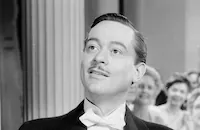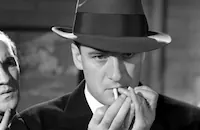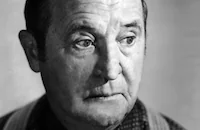King of the Underworld

Brief Synopsis
Cast & Crew
Lewis Seiler
Humphrey Bogart
Kay Francis
James Stephenson
John Eldredge
Jessie Busley
Film Details
Technical Specs

Synopsis
Dr. Niles Nelson, an inveterate horse player, is lured by the promise of easy money into becoming doctor to crime boss Joe Gurney and his gang. When Niles is killed by the police while attending to one of Gurney's men, his wife, Dr. Carol Nelson, falls under suspicion of also being in league with the gangsters. Under threat of having her license revoked, Carol is desperate to establish her innocence, and sets up her medical practice in the small town in which two of Gurney's gangsters have been imprisoned. Her plans go awry, however, when Gurney, who entertains delusions of Napoleonic grandeur, breaks into the jail and frees his men. Wounded in the jailbreak, Gurney calls upon Mary and forces her to bandage his arm. Also wounded in the jailbreak is down-and-out writer Bill Stevens, who had innocently accepted a ride from the notorious gangster. Carol befriends Bill, who is later taken prisoner by Gurney so that he can write the gangster's autobiography. When his wound worsens, Gurney sends for Carol. Realizing that the federal agents are coming to arrest her for her involvement with Gurney, Carol formulates a plan to capture the mobster and his henchmen. Convincing Gurney and his men that they have an eye infection, Carol temporarily blinds the mobsters with adrenaline eye drops and calls for the federal agents to close in. After a blinded Gurney is mowed down in a gun battle with the "feds," Carol is exonerated and begins life anew with Bill.

Director
Lewis Seiler
Cast

Humphrey Bogart

Kay Francis

James Stephenson

John Eldredge
Jessie Busley
Arthur Aylesworth
Raymond Brown
Harland Tucker
Ralph Remley
Charles Foy
Murray Alper
Joe Devlin

Elliott Sullivan
Alan Davis
John Harmon

John Ridgely
Richard Bond

Pierre Watkin
Charles Trowbridge
Edward Stanley
Herbert Heywood
Paul Macwilliams

Richard Quine

Ralph Dunn
Max Hoffman Jr.
Janet Shaw

Ann Robinson
Stuart Holmes
Lew Harvey
Edgar Dearing
William Gould
Davison Clark
Carl Stockdale
Nat Carr

Clem Bevans

Tom Wilson
Glen Cavender
Sidney Bracy
Lottie Williams
Jimmy O'gatty
Frank Bruno

Paul Panzer
Cliff Saum
Doc Stone
Jerry Fletcher
Peggy Moran
Francis Sayles
Sherwood Bailey
Al Lloyd

Jack Mower
John Harron
Vera Lewis

Frank Orth
Crew
George Bricker
E. A. Brown
W. R. Burnett
Frank Dewar
Leo F. Forbstein
Bryan Foy
Frank Heath
Sid Hickox
Charles Novi
Orry-kelly
Dr. Leo Schulman
Vincent Sherman
Vincent Sherman
Jack L. Warner

Photo Collections
Videos
Movie Clip


Trailer
Film Details
Technical Specs

Articles
King of the Underworld
King of the Underworld began as a vehicle for now-forgotten but once-popular leading lady Kay Francis. A bona fide star for both Paramount and Warners in the early-to-mid thirties, the Oklahoma-born actress gradually lost favor with the ascendancy of Bette Davis but held on to her $200,000 annual salary much to the chagrin of money-minded studio boss Jack Warner. Convinced Francis would bail on her long-term contract rather than appear in a lurid crime film, Warner green-lighted a distaff remake of Dr. Socrates (1935), with Francis cast in the Paul Muni role of an underworld physician slowly drawn into a life of crime. To Warner's displeasure, Francis accepted the role, declaring that for her asking price she'd mop the soundstages. (The studio vexed the actress in other ways, including making her help out with the screen tests of up-and-coming actors.) While shooting the film, then called Unlawful, for two weeks in the summer of 1938, Francis got along well with the second-billed Bogart (cast as a gangster with a Napoleon complex and a fatal reach-grasp disarticulation). The pair had friends in common (among them, writer Louis Bromfield) and even joined forces to help out with the script, which was unfinished at the start of principal photography. (By all accounts, in-house director Lewis Seiler rarely consulted the shooting script even up to the night before blocking a scene.) While shooting a trailer for the film, Bogart indulged in a little payback for the Warners elite, appending the teaser line "I'm King of the Underworld and nobody is better than I am..." with the ad libbed capper "... and that goes for you, too, Jack Warner!"
When Unlawful was released in January of 1939, Kay Francis learned that Warners had one final indignity in store for her...they'd given Humphrey Bogart star billing above the new King of the Underworld title and relegated her to second-billed status (in a decidedly smaller title card font). Whatever her private feelings, Francis swallowed her pride at this latest slap in the face and soldiered on, perhaps comforted by the fact that she earned nearly ten times Bogart's salary. For his part, Bogart was not happy to be used as a pawn in a ploy to humiliate Francis in front of the public that once loved her; the fact that the gesture had afforded him his first star billing only rubbed salt into the wound.
Bogart toughed out another miserable year at Warners but there was light at the end of the tunnel. When George Raft turned down the role of Roy "Mad Dog" Earle in Raoul Walsh's High Sierra (1941), Bogart filled the slot (as he often did when Raft rejected a script) and was pointed toward the star vehicles that would make his career. Within three years, Bogart had both The Maltese Falcon (1941) and Casablanca (1942) under his belt and was one of Warner Brothers' most in-demand and highest paid stars. In 1944, he was nominated for an Academy Award® for "Best Lead Actor" for Casablanca, an honor that would at last be his (for The African Queen, 1951) five years before his untimely death from throat cancer in January of 1957.
Director: Lewis Seiler
Screenplay: George Bricker, Vincent Sherman; W.R. Burnett (story "Dr. Socrates")
Cinematography: Sid Hickox
Art Direction: Charles Novi
Music: Heinz Roemheld (uncredited)
Film Editing: Frank Dewar
Cast: Humphrey Bogart (Joe Gurney), Kay Francis (Dr. Carole Nelson), James Stephenson (Bill Stevens), John Eldredge (Dr. Niles Nelson), Jessie Busley (Aunt Josephine), Arthur Aylesworth (Dr. Sanders), Raymond Brown (sheriff), Harland Tucker (Mr. Ames), Ralph Remley (Mr. Robert), Charley Foy (Slick), Murray Alper (Eddie), Joe Devlin (Porky).
BW-67m. Closed captioning.
by Richard Harland Smith
Sources:
Kay Francis, A Passionate Life and Career by Lynn Kear and John Rossman
Bogart by A, M. Sperber and Eric Lax
Bogie: The Films of Humphrey Bogart by Cliff McCarty
The Warner Brothers Story by Clive Hirschhorn
The Film Encyclopedia by Ephraim Katz

King of the Underworld
Quotes
Trivia
Notes
The working title of this film was Unlawful. Many of the onscreen credits differ from credits listed in the reviews. In the Variety review, the character of "Bill Stevens" was named "Bill Forrest" and "Aunt Josephine" was "Aunt Margaret." The Variety review also credits Charles Foy with the role of "Eddie," Murray Alper with that of "Butch" and Alan Davis with the role of "Slick."

Miscellaneous Notes
Released in United States 1939
Released in United States 1939














